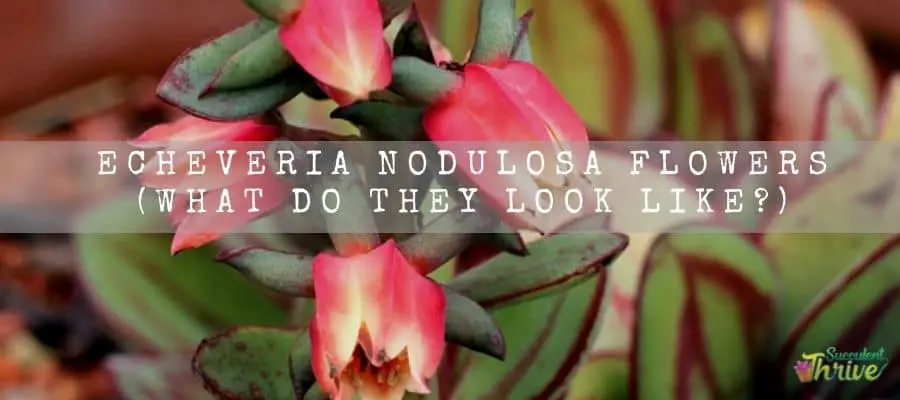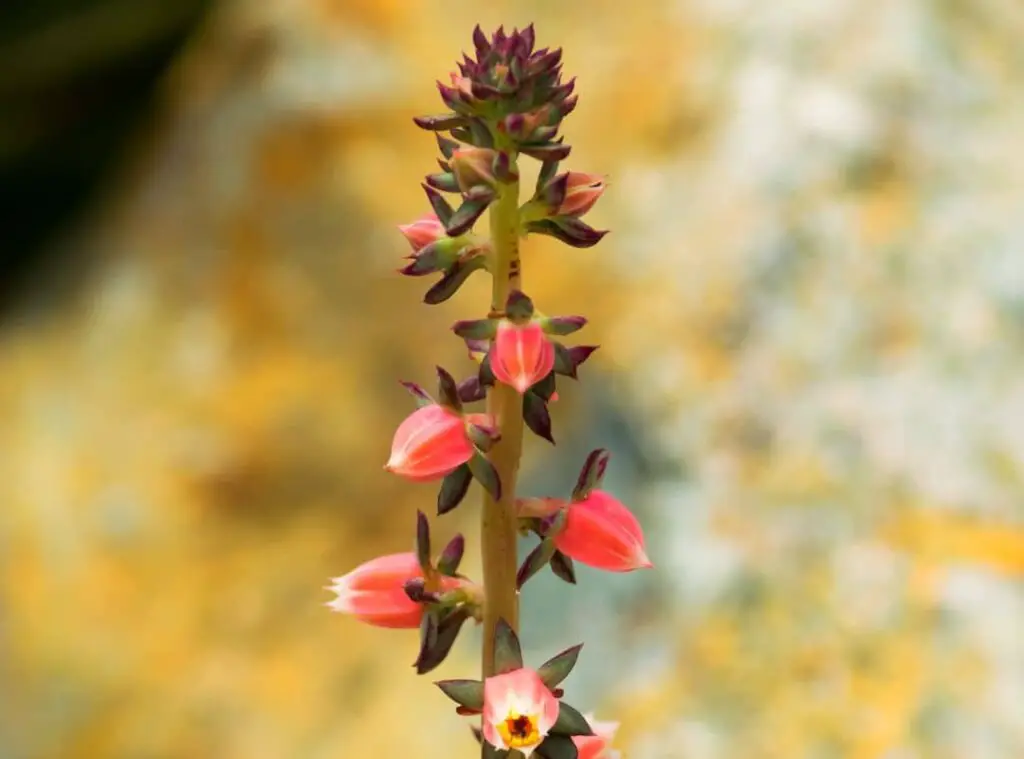Do Echeveria nodulosa flowers? Yes and Echeveria nodulosa flowers emerged in summer and those flowers would be dull yellow in color.
They would usually develop a flower spike of 2 feet tall ( 60 cm) and that would arise right on top of the rosette of the plants.

Echeveria nodulosa are an extraordinary set of plants which would catch anybody’s attention at the first glance. They are ever green rosette forming plants. If I briefly touch on the sizes of the plants, they would be 2-3 feet broad and 1-2 feet tall.
Echeveria nodulosa leaves would be fleshy to the touch and tend to take a pointed shape. The leaves would be prominent in olive green color and they may also comprise of red patches in the center and the margins of the leaves.
The Echeveria nodulosa plants usually grow at a moderate rate. They plants are hailing from Central America and they make limestone hills as their natural habitats most of the time.
Echeveria nodulosa are renowned for their magnificent looks and for their multicolored foliage as well. The dull, yellow-colored blooms along with hues in red make them look even more pretty.
Those flowers do not release any fragrance in general. So, let’s find out more on the Echeveria nodulosa flowers, how to care for them and how to encourage them to flowering etc.
How often do Echeveria nodulosa flowers?
Echeveria nodulosa produces flowers usually during summer.
Colors of Echeveria nodulosa flowers
You could spot them producing flowers in dull yellow. However, they may have red hues as well.
How long do Echeveria nodulosa flowers last?
Echeveria nodulosa blooms would stay alive for about two weeks’ time in general. This is usually the lifetime of all the Echeveria blooms and Echeveria nodulosa flowers are no different to them. This literally means you have sufficient time to enjoy seeing them in full blossom.
Do they die after flowering?
Echeveria nodulosa are not the type of plants which would perish right after they flower. It literally means they are not monocarpic flowers. They can produce flowers many times during their lifetime.
How to make Echeveria nodulosa flowers?
Echeveria nodulosa would produce flowers if they get ideal conditions to grow. If they get the required conditions, they will certainly reward you with some fantastic blooms in return.
That said , if you have Echeveria nodulosa grown for some time and can’t spot them flowering, it could be literally due to lapses in the way you take care of them.
However, at first keep in mind that Echeveria nodulosa would flower only if they are at least four or five years old. Literally , it is very unlikely that young Echeveria nodulosa would bloom.
First, if you are growing Echeveria nodulosa whilst exposing for low light levels, it is very unlikely that they would produce flowers.
It is important that Echeveria nodulosa get sufficient energy so that they can produce the taller flower stalks in the plants.
Hence , keep in mind that you should supply them with sufficient sunlight levels for them. Give them morning full sunlight for about 5-6 hours for best results.
On the other hand, if your plants are developing lengthy growths , it literally means the plants are lacking sufficient sunlight.
Excess watering could be yet another reason as to why your Echeveria nodulosa may not flower. So, to encourage them to flowering, you need to water them moderately yet infrequently.
Bear in mind that, Echeveria nodulosa have water conserved in their bodies and excess water could be something fatal on the plants as well.
Do not ever leave the Echeveria nodulosa roots exposed to soggy conditions. Always water them thoroughly and sparingly.
Feed the plants when they are actively growing. There are fertilizers which are specially made to stimulate the flower blossoming of the plants and you may proceed with one of them and apply them when they’re actively growing.
Ideally you need to choose a fertilizer which has a higher component of Phosphorus so that it would encourage the flower blossoming of the plants.
I suggest you use a fertilizer which has a 5-10-5 ratio. Ensure that you dilute it and then use it. Apply this from April to September.
Provide a well-draining and a well aerated soil mix also to make them flower. If you end up using a soil mix which has poor drainage it would lead to health deterioration of the plants and affect the flower formation also in a bad manner.
Always expose them for warmer temperatures and protect the plants from colder conditions also. If there are too extreme temperatures, it would badly impact the flower blossoming activity of the plants.
Ideally you need to refrain from exposing the plants for too hot conditions and for too cold conditions also. If you adhere to these tips you can witness Echeveria nodulosa are in full blossom during summer.

How to care for Echeveria nodulosa flowers?
Light requirement
Echeveria nodulosa prefers to have both full sunlight and partial shade for their vigorous growth.
Ideally 5-6 hours of full sunlight in the morning hours along with partial shade during warmest hours of the day would work well with them. keep in mind to place the plants in a shady spot during the warmest hours of the day.
Unless, if you expose the plants to the scorching sun , it can even scorch the plants leaves as well as the flowers. so, best is to locate them in a place where they can gain bright indirect sunlight.
If it’s indoors, you can grow them near bright sunny windows and if it is outdoors, you can grow them under taller trees or in any other place where they will be protected from intense sunlight. Keep in mind that Echeveria nodulosa are prone to get sunburnt.
Watering requirement
Echeveria nodulosa are succulents which literally means they don’t have a big demand for water. Less watering would be more than enough for the plants.
Ideally you can water them once every two weeks or even less than that when they are dormant. Echeveria nodulosa roots are quite responsive towards over watering.
Literally over exposure for water could make the whole plant rot and lead to death as well. I suggest you let the soil wither between two watering sessions. Having said that, don’t let them become bone dry also.
On the other hand, you should water the plants with caution and refrain from spilling water on the leaves.
If you do so, you need to immediately wipe them off. Always keep in mind to avoid over watering them as it would even lead to the death of the plants.
Soil requirement
Echeveria nodulosa opt to grow in a dry environment which literally means they would prefer to have a well-draining soil mix as their growing medium.
Many succulent enthusiasts opt to go ahead with commercially made succulents and cactus soil mix to grow the Echeveria nodulosa as they have an excellent drainage.
It is very important that you proceed with a well-draining soil mix as if not you won’t be able to reap the best results despite how accurately you water the plants.
You can easily find them at garden stores and at nurseries as well. That said , if you wish you may also use a soil mix which is combined with sand and potting soil. However, it would be somewhat time consuming in terms of drying out.
Temperature and humidity
A temperature range of around 65 degrees Fahrenheit – 72 degrees Fahrenheit would be the best for the Echeveria nodulosa plants.
Colder temperatures would not be healthy for these plants. If you happen to come across any signs of frost damage, you should immediately bring them indoors to protect the plants.
Humidity wise, I suppose 50 % humidity would work well with them. If there are low humidity levels, I encourage you to mist them.
Conclusion
The sight of Echeveria nodulosa flowers would be a breathtaking view which you could spot in summer.
So, I hope that you were able to educate yourself in how to encourage them to produce flowers and on the after-care tips of the plants once they complete flowering.
Read Next : Astrophytum Myriostigma Var. Nudum | A Unique One |
